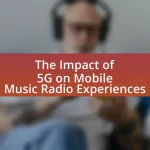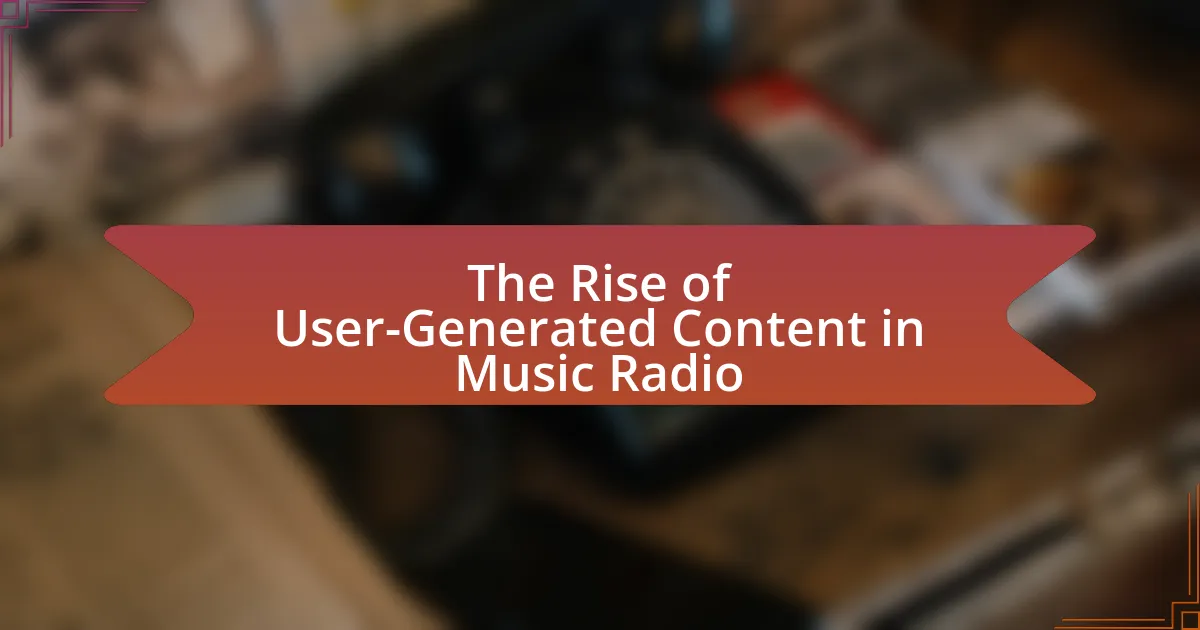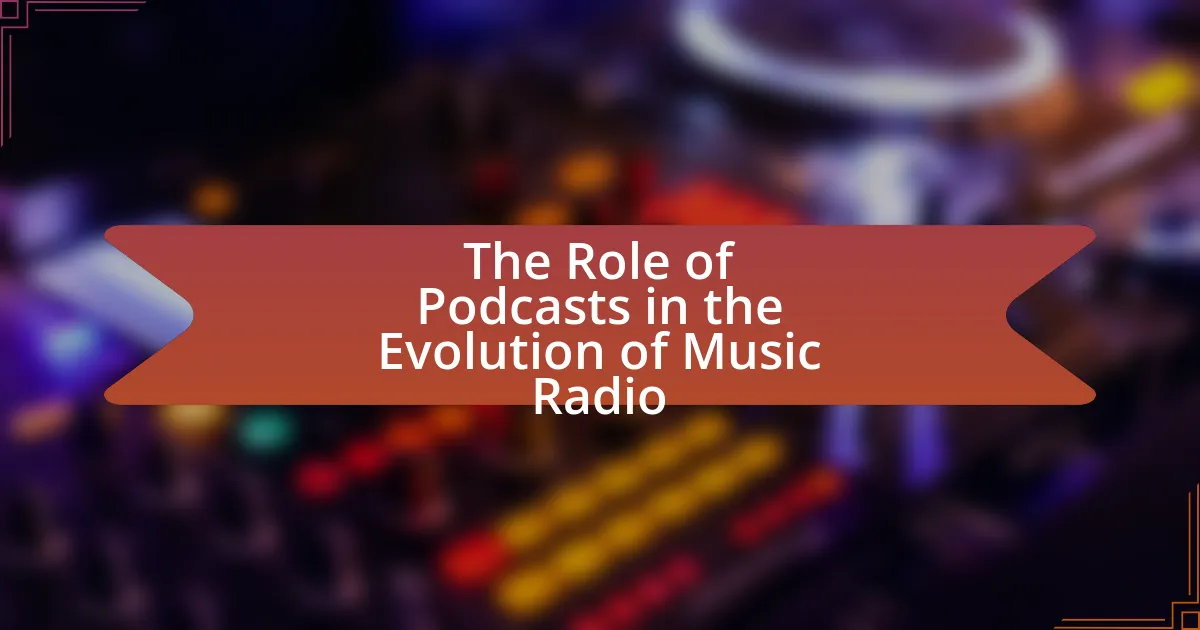The article examines the significant influence of social media on music radio trends, highlighting how platforms like Instagram, TikTok, and Twitter shape listener preferences and promote new artists. It discusses the transformation of music radio through direct artist-to-fan communication, real-time audience engagement, and the impact of user-generated content on song popularity. Key trends include the rise of niche genres, the importance of social media metrics in playlist curation, and the strategies artists and radio stations employ to adapt to this evolving landscape. The article emphasizes the necessity for industry stakeholders to understand these dynamics to enhance audience engagement and maintain relevance in a competitive environment.
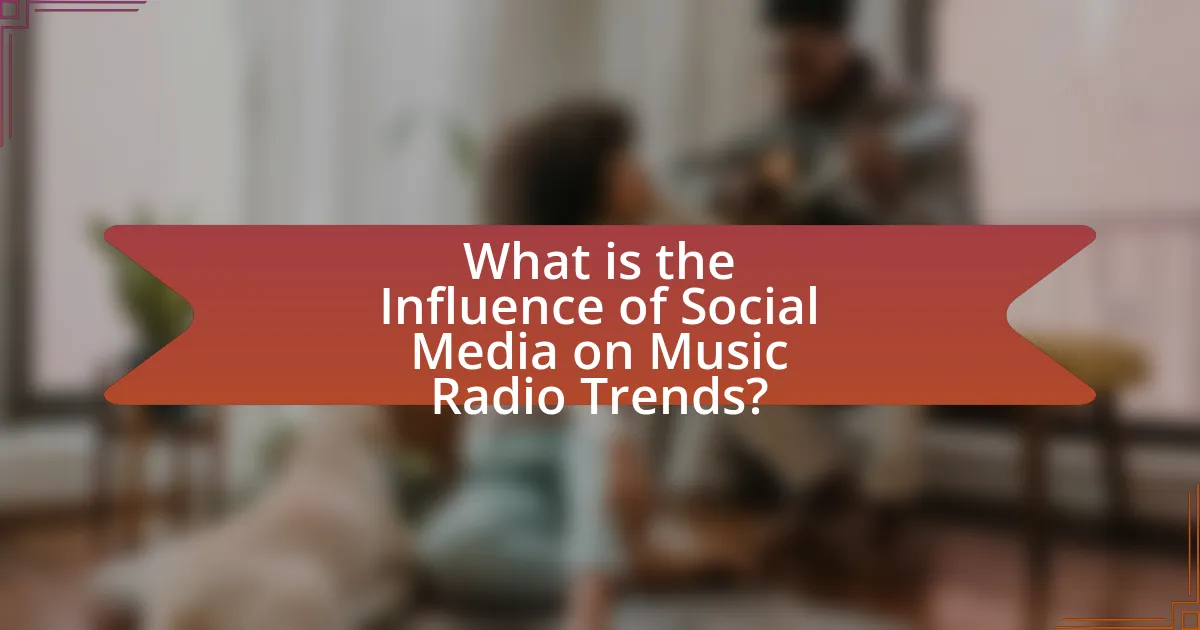
What is the Influence of Social Media on Music Radio Trends?
Social media significantly influences music radio trends by shaping listener preferences and promoting new artists. Platforms like Instagram, TikTok, and Twitter allow artists to engage directly with fans, leading to viral hits that radio stations often adopt to stay relevant. For instance, songs that gain traction on TikTok frequently see increased airplay on radio, as evidenced by the rise of tracks like “Old Town Road” by Lil Nas X, which gained popularity through social media before dominating radio charts. This trend illustrates how social media acts as a catalyst for music discovery, directly impacting what is played on radio stations.
How has social media changed the landscape of music radio?
Social media has transformed the landscape of music radio by enabling direct artist-to-fan communication and facilitating real-time audience engagement. Platforms like Twitter, Instagram, and TikTok allow artists to promote their music, share updates, and interact with listeners, which enhances listener loyalty and engagement. According to a 2021 Nielsen report, 70% of music listeners engage with artists on social media, indicating a significant shift in how audiences connect with music. This direct interaction has led to increased visibility for emerging artists and has changed how radio stations curate playlists, often incorporating trending songs from social media platforms to stay relevant.
What specific social media platforms are most influential in this change?
The specific social media platforms most influential in the change of music radio trends are Instagram, TikTok, and Twitter. Instagram facilitates visual storytelling and artist engagement, allowing musicians to share snippets of their work and connect with fans, which drives trends. TikTok has rapidly become a powerful platform for music discovery, with viral challenges and trends leading to significant increases in song popularity, as evidenced by the Billboard charts reflecting songs that gained traction on the platform. Twitter serves as a real-time communication tool where artists and fans discuss music, share updates, and promote new releases, influencing listener preferences and trends in the industry.
How do user-generated content and interactions shape music radio trends?
User-generated content and interactions significantly shape music radio trends by influencing song popularity and listener engagement. Platforms like social media allow users to share their music preferences, create playlists, and engage in discussions, which directly impacts what songs are played on radio stations. For instance, data from Nielsen shows that songs trending on platforms like TikTok often see increased airplay on radio, as stations aim to align with listener interests. Additionally, listener feedback through social media can prompt radio stations to adjust their playlists, reflecting real-time audience preferences and fostering a more interactive listening experience. This dynamic interaction between users and radio stations creates a feedback loop that continuously shapes music trends.
Why is understanding this influence important for the music industry?
Understanding the influence of social media on music radio trends is crucial for the music industry because it directly impacts how artists reach audiences and how music is consumed. Social media platforms facilitate real-time engagement between artists and fans, allowing for immediate feedback and promotion, which can significantly boost an artist’s visibility and popularity. For instance, a study by Nielsen Music found that 56% of music listeners discover new music through social media, highlighting its role as a primary discovery tool. This understanding enables industry stakeholders to adapt marketing strategies, optimize content distribution, and enhance audience engagement, ultimately driving sales and streaming numbers.
What implications does this have for artists and music producers?
The influence of social media on music radio trends significantly impacts artists and music producers by altering how they promote their work and engage with audiences. Artists must adapt to the rapid dissemination of music through platforms like Instagram and TikTok, which can lead to viral success or failure based on audience reception. For instance, songs that gain traction on TikTok can see a substantial increase in streaming numbers, as evidenced by the rise of tracks like “Old Town Road” by Lil Nas X, which gained popularity through social media before topping charts. Music producers are also affected, as they need to consider social media trends when creating music, ensuring that their productions align with what resonates with listeners online. This shift necessitates a more interactive approach to marketing and audience engagement, emphasizing the importance of building a strong online presence to remain relevant in a competitive industry.
How does this influence affect radio station programming and marketing strategies?
The influence of social media significantly affects radio station programming and marketing strategies by driving audience engagement and content curation. Radio stations increasingly tailor their playlists and programming to align with trending topics and popular songs on social media platforms, ensuring they remain relevant to listeners. For instance, data from Nielsen indicates that 60% of radio listeners discover new music through social media, prompting stations to incorporate viral hits into their rotations. Additionally, marketing strategies are adapted to leverage social media for promotional campaigns, utilizing platforms like Instagram and TikTok to reach younger demographics, as 71% of millennials and Gen Z use these platforms for music discovery. This integration of social media trends into programming and marketing enhances listener loyalty and expands audience reach.
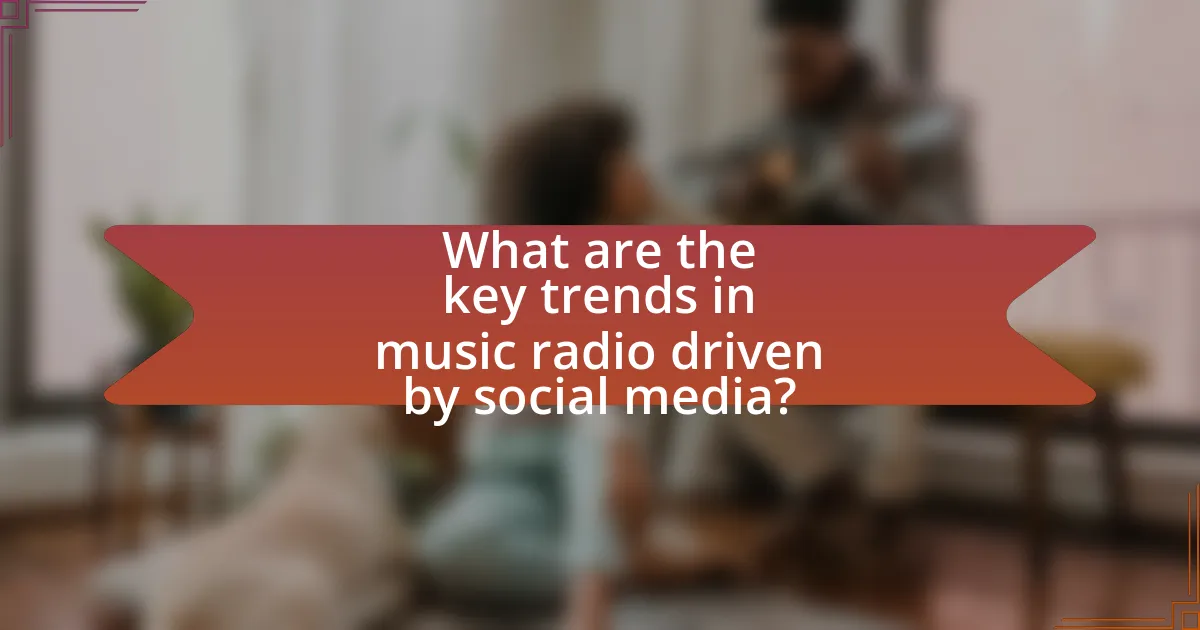
What are the key trends in music radio driven by social media?
Key trends in music radio driven by social media include increased audience engagement, real-time feedback, and the rise of user-generated content. Social media platforms enable listeners to interact with radio stations and artists, fostering a sense of community and loyalty. For instance, platforms like Twitter and Instagram allow fans to share their thoughts on songs and playlists instantly, influencing programming decisions. Additionally, the integration of social media into radio broadcasts, such as live tweeting during shows or featuring listener comments, enhances the listening experience. According to a 2022 Nielsen report, 60% of radio listeners engage with stations on social media, highlighting its significant role in shaping music radio trends.
How do social media metrics impact music radio playlists?
Social media metrics significantly impact music radio playlists by influencing song selection based on audience engagement and popularity. Radio stations analyze metrics such as likes, shares, comments, and streaming numbers from platforms like Twitter, Instagram, and Spotify to gauge listener preferences. For instance, a study by Nielsen Music found that songs trending on social media platforms often see increased airplay, as stations aim to attract listeners by featuring popular tracks. This correlation between social media engagement and playlist curation demonstrates how radio stations adapt to audience interests, ensuring their playlists remain relevant and appealing.
What role do streaming numbers play in shaping radio airplay decisions?
Streaming numbers significantly influence radio airplay decisions by providing data on listener preferences and trends. Radio stations analyze streaming metrics to identify popular songs and artists, which helps them curate playlists that align with audience demand. For instance, a study by Nielsen Music found that songs with high streaming numbers are more likely to receive increased airplay, as stations aim to attract larger audiences by playing music that listeners are already engaging with online. This correlation between streaming success and radio play underscores the importance of digital consumption patterns in shaping traditional media strategies.
How do social media challenges and trends influence song popularity?
Social media challenges and trends significantly influence song popularity by creating viral moments that drive listener engagement and streaming numbers. For instance, songs that become associated with popular TikTok challenges often see a surge in streams and chart performance, as evidenced by the rise of tracks like “Savage Love” by Jawsh 685 and Jason Derulo, which gained immense popularity through a viral dance challenge. This phenomenon occurs because social media platforms facilitate rapid sharing and exposure, allowing songs to reach wider audiences quickly. Additionally, data from the Nielsen Music report indicates that songs featured in viral trends can experience a 200% increase in streaming activity, demonstrating the direct correlation between social media engagement and song popularity.
What are the emerging genres and styles in music radio due to social media?
Emerging genres and styles in music radio due to social media include lo-fi hip hop, bedroom pop, and genre-blending tracks that combine elements from various musical styles. Social media platforms like TikTok and Instagram have accelerated the popularity of these genres by allowing users to share short clips of songs, leading to viral trends. For instance, lo-fi hip hop gained traction as users sought relaxing background music for study sessions, while bedroom pop has become popular for its DIY aesthetic and relatable themes, often showcased through user-generated content. The accessibility of music creation tools and the ability to share music instantly on social media have further contributed to the rise of these genres, reshaping the landscape of music radio.
How has social media contributed to the rise of niche genres on radio?
Social media has significantly contributed to the rise of niche genres on radio by providing platforms for targeted promotion and community engagement. Through social media channels, artists and fans can connect directly, allowing niche genres to gain visibility and cultivate dedicated followings. For instance, platforms like Instagram and TikTok enable musicians to share their work with specific audiences, leading to increased interest in genres that may not have mainstream appeal. Data from a 2021 Nielsen report indicates that 70% of listeners discover new music through social media, highlighting its role in shaping listener preferences and driving the popularity of niche genres.
What are the characteristics of music that gains traction on social media?
Music that gains traction on social media typically possesses catchy melodies, relatable lyrics, and strong emotional resonance. Catchy melodies facilitate easy recall and sharing, while relatable lyrics connect with listeners’ personal experiences, enhancing engagement. Strong emotional resonance evokes feelings that encourage users to share the music with their networks. Additionally, music that incorporates trending sounds or challenges, such as those popularized on platforms like TikTok, often sees increased virality. For instance, songs that become associated with specific dance challenges or memes can rapidly gain popularity, as evidenced by tracks like “Savage Love” by Jawsh 685 and Jason Derulo, which gained massive traction through TikTok challenges.

How do artists leverage social media to influence music radio trends?
Artists leverage social media to influence music radio trends by actively engaging with their audience, promoting their music, and creating viral content that captures listener interest. Through platforms like Instagram, Twitter, and TikTok, artists can share snippets of their songs, behind-the-scenes content, and personal stories, which fosters a direct connection with fans. This engagement often leads to increased streaming numbers and radio play, as radio stations monitor social media trends to identify popular tracks. For instance, songs that gain traction on TikTok frequently see a corresponding rise in radio airplay, as evidenced by the success of tracks like “Old Town Road” by Lil Nas X, which became a cultural phenomenon partly due to its viral presence on social media.
What strategies do artists use to engage with their audience on social media?
Artists engage with their audience on social media through strategies such as interactive content, regular updates, and personalized communication. Interactive content includes polls, Q&A sessions, and live streams, which foster direct engagement and create a sense of community. Regular updates about new releases, behind-the-scenes content, and personal stories keep the audience informed and invested in the artist’s journey. Personalized communication, such as responding to comments and messages, enhances the connection between artists and their fans, making followers feel valued and heard. These strategies are supported by data indicating that artists who actively engage with their audience see higher levels of fan loyalty and increased sharing of their content, ultimately leading to greater visibility and success in the music industry.
How do collaborations and features promoted on social media impact radio play?
Collaborations and features promoted on social media significantly enhance radio play by increasing visibility and audience engagement. When artists collaborate and share their work on platforms like Instagram and Twitter, they tap into each other’s fan bases, leading to a broader reach. For instance, a study by Nielsen Music found that songs featuring multiple artists receive 30% more airplay than solo tracks, demonstrating the effectiveness of collaborative promotion. Additionally, social media allows for real-time interaction and feedback, which can create buzz around a song, further encouraging radio stations to play it. This dynamic illustrates how social media serves as a catalyst for increased radio exposure through strategic collaborations.
What role does storytelling through social media play in an artist’s radio success?
Storytelling through social media significantly enhances an artist’s radio success by creating a deeper emotional connection with the audience. This connection fosters listener loyalty and engagement, which are crucial for radio play. For instance, artists who share personal narratives or behind-the-scenes content can humanize their brand, making listeners more likely to support their music. Research indicates that 70% of consumers prefer to learn about a brand through storytelling rather than traditional advertising, highlighting the effectiveness of this approach. Additionally, social media platforms allow artists to reach wider audiences, increasing their chances of being featured on radio stations. This multifaceted engagement strategy ultimately leads to higher streaming numbers and radio airplay, reinforcing the importance of storytelling in an artist’s overall success in the music industry.
How can radio stations adapt to the influence of social media?
Radio stations can adapt to the influence of social media by integrating interactive platforms that engage listeners and promote content sharing. By utilizing social media channels, radio stations can create real-time interactions through live polls, listener requests, and social media shout-outs, which enhance audience participation. For instance, a study by Nielsen in 2021 indicated that 60% of radio listeners engage with stations via social media, highlighting the importance of this integration. Additionally, radio stations can leverage social media analytics to understand listener preferences and tailor their programming accordingly, ensuring they remain relevant in a rapidly evolving media landscape.
What best practices should radio stations implement to stay relevant?
Radio stations should implement a multi-platform strategy that integrates social media engagement, audience interaction, and content diversification to stay relevant. By actively utilizing platforms like Instagram, Twitter, and TikTok, radio stations can reach younger demographics and foster community engagement. For instance, a study by the Pew Research Center indicates that 69% of adults use social media, highlighting its importance in audience connection. Additionally, incorporating listener feedback into programming and offering exclusive online content can enhance listener loyalty and attract new audiences. This approach not only modernizes the radio experience but also aligns with current media consumption trends, ensuring radio stations remain competitive in a digital landscape.
How can radio stations effectively use social media for audience engagement?
Radio stations can effectively use social media for audience engagement by creating interactive content that encourages listener participation. This includes hosting live Q&A sessions, conducting polls about music preferences, and sharing behind-the-scenes content that fosters a sense of community. For instance, a study by the Pew Research Center found that 69% of adults in the U.S. use social media, indicating a vast audience that radio stations can tap into. By leveraging platforms like Instagram and Twitter, radio stations can share real-time updates, promote upcoming shows, and engage with listeners through comments and direct messages, thereby enhancing listener loyalty and increasing audience reach.
What are the challenges faced by music radio in the age of social media?
Music radio faces significant challenges in the age of social media, primarily due to competition for audience attention and the shift in music consumption habits. Social media platforms like Spotify and YouTube allow users to access music on-demand, diminishing the traditional radio’s role as a primary source for discovering new music. According to a Nielsen report, 63% of U.S. adults listen to music through streaming services, highlighting a substantial shift away from radio. Additionally, social media enables artists to connect directly with fans, reducing the reliance on radio for promotion. This direct engagement often leads to a fragmented audience, making it difficult for music radio to maintain listener loyalty and relevance in an increasingly digital landscape.
How do changing listener habits affect traditional radio models?
Changing listener habits significantly impact traditional radio models by shifting audience preferences towards on-demand and digital platforms. As listeners increasingly favor streaming services and podcasts, traditional radio faces declining audience numbers and advertising revenue. For instance, a Nielsen report from 2021 indicated that 62% of Americans listen to online radio, while traditional AM/FM radio listenership has decreased, particularly among younger demographics. This shift forces traditional radio to adapt by integrating digital content, enhancing interactivity, and leveraging social media to engage audiences, thereby redefining their operational models to remain relevant in a rapidly evolving media landscape.
What are the risks of relying too heavily on social media trends?
Relying too heavily on social media trends poses significant risks, including the potential for misinformation and the erosion of authentic content. Social media platforms often prioritize sensationalism and virality over accuracy, leading to the spread of false information that can misguide audiences. For instance, a study by the Pew Research Center found that 64% of Americans believe that fabricated news stories cause confusion about the basic facts of current events. Additionally, an overemphasis on trends can stifle creativity and originality in music, as artists may feel pressured to conform to popular styles rather than innovate. This trend-driven approach can result in a homogenization of music, diminishing diversity and artistic expression within the industry.
What practical tips can artists and radio stations use to navigate this influence?
Artists and radio stations can navigate the influence of social media by actively engaging with their audience through consistent content sharing and interaction. This engagement fosters a community around their music, allowing artists to build a loyal fan base while radio stations can enhance listener loyalty. For instance, artists should utilize platforms like Instagram and TikTok to showcase behind-the-scenes content, which has been shown to increase audience connection and interest. Radio stations can leverage social media analytics to understand listener preferences and tailor their playlists accordingly, ensuring they remain relevant in a rapidly changing music landscape. According to a 2022 Nielsen report, 70% of music listeners discover new songs through social media, highlighting the importance of these platforms in shaping music trends.

